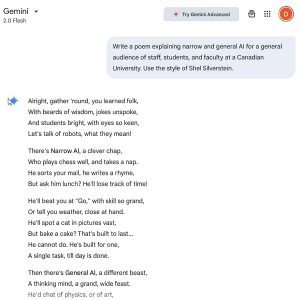1.1 What is Generative AI?
Overview and Outcomes
Artificial Intelligence (AI) is a quickly evolving field with increasing impact on our daily lives. Generative AI is only one subfield of AI, but it has had (and will continue to have) a profound impact on how we produce knowledge and information media.
By the end of this section, you will be able to:
- Describe what generative AI is and how it compares to other AI technologies
- Explain how generative AI , including Large Language Models, works at a high level
- Identify common applications of generative AI
- Explain the limitations and strengths of generative AI
What is generative AI?

Generative AI is a type of Artificial Intelligence that creates new content, including text, images, videos, audio, and computer code. It is trained to identify patterns, relationships, and characteristics of existing data, and then mimic those patterns and relationships when creating new content. It is called “generative” because it generates new content based on these patterns. For example, the image on the right shows a new piece of artwork in the style of Gustav Klimt. Below, is an AI Generated poem in the style of Shel Silverstein generated in March 2025 using Google Gemini. As discussed in the Ethics section, although generative AI technologies are quite good at mimicking style, the ability to mimic writing and art styles of specific authors and artists has led to numerous controversies around intellectual property and copyright.

Where does generative AI fit into the AI landscape?

Artificial Intelligence (AI) are technologies that can simulate human intelligence by performing tasks that require the ability to reason, learn, and act independently. In popular media, AI is often represented as nearly indistinguishable from humans (for example the Cylons in Battlestar Galactica ![]() or the Replicants in Bladerunner
or the Replicants in Bladerunner ![]() ). In the present, AI systems are not quite this advanced, but they are becoming more advanced and able to tackle increasingly complex tasks.
). In the present, AI systems are not quite this advanced, but they are becoming more advanced and able to tackle increasingly complex tasks.
Generative AI models are a specialized type of Artificial Intelligence built using Deep Learning techniques to create new content. Deep Learning systems are modelled on the neural networks in the human brain, which allows them to perform very complex tasks like image and speech recognition and generation.
Some generative AI models are Large Language Models (LLMs). LLMs are specifically trained for natural language processing and production tasks. They are pre-trained on large amounts of text, and from this text they learn patterns of syntax and semantics in human language. Large Language Models are used in both discriminative and generative AI systems, meaning that they can be used to both classify new input (for example, to decide if a new email message is spam or not) and to generate new content (for example, to write a new email message asking for an extension on a piece of work).
LLMs are typically general-purposed, meaning that they are trained to solve common language problems. They can be used for:
- Translation
- Text classification
- Text prediction / completion
- Text generation
- Text revision
Examples of Large Language Models include GPT-4, Claude, Gemini, and LlaMA.
Pre-trained LLMs can be further trained on a smaller task or domain specific datasets to allow them to achieve better results or perform specialized tasks. This process is called fine-tuning. For some LLMs, fine-tuning can be done by the end user.
For example, imagine that we wanted to create a TA ChatBot for a course on Information Ethics. An existing LLM would have the foundational understanding of language and perhaps some knowledge on the topic but may not have the specialized knowledge of all of the content covered in the course. This model could be fine-tuned using all of the course readings, lectures, and other course content. This would increase its ability to respond accurately to specific course questions.
Diffusion Models are another type of deep learning that can be used to learn and replicate patterns in visual data. Many image or video generating tools use Diffusion Models. Examples of image-generating diffusion models include Adobe Firefly, MidJourney, DALL-E, and Stable Diffusion.

Most of the examples and activities in this resource will focus on LLMs.
What are common applications of generative AI technologies?
ChatBots are one example of a modern user interface that has made access to generative AI models much easier for the general public. ChatBots are designed to simulate human conversation by accepting natural language prompts or inputs and producing responses in natural language. They can be built on LLMs, allowing them to provide sophisticated responses to prompts. Note that not all chatbots are generative; many are rule-based, meaning they have a set of pre-defined responses to prompts and do not generate unique or original text.
Popular generative AI ChatBots include:
- Microsoft Copilot
 (accessible with your UWO credentials)
(accessible with your UWO credentials) - ChatGPT

- Google Gemini

- Claude

The functionality of these tools is constantly changing; however, currently many of these tools are able to accept multiple types of input (e.g. text, images, files) and produce multiple types of output.
AI technologies are embedded in many other technological tools and processes. Examples of other places you may encounter AI on a daily basis include:
- Digital voice assistants (Siri, Alexis, Cortana) which use AI for voice recognition, to understand and process requests, to generate responses to requests and for a variety of other tasks.
- Text Editors (Grammarly, Microsoft Office) which use AI to generate grammar, style, and word choice suggestions
- Auto-captioning tools (Zoom, Otter.ai) which use AI for voice recognition and word recognition; they may also use AI training models to learn specific voices and improve their captioning.
- Search Engines (Google, Bing) which use AI to understand and process requests, to optimize search results, to analyze images for image searches, to generate responses, and for a variety of other tasks.
- Grading Tools (Gradescope) which use AI for text recognition and to group similar responses together to aid marking tasks.
 Stop and Reflect: Where is AI?
Stop and Reflect: Where is AI?
As you use different technologies over the next 24 hours, make note of where you are noticing AI capabilities appearing. What do these tools do? How does AI add to the functionality of the technology?
Any technology or process that allows machines to mimic human cognition.
Computational models that are trained on huge datasets of text to recognize common patterns and relationships in natural language. They can be used for generating texts that mimic human language.
A subset of machine learning that uses artificial neural networks modelled on the human brain to identify rules or patterns in data.
LLMs are trained on massive amounts of text before they are released to allow them to learn patterns and relationships.
AI interfaces designed to simulate conversation.
Generative AI is a type of Artificial Intelligence that creates new content, including text, images, videos, audio, and computer code.
A prompt is the text that is provided to the system providing instructions on the desired output or the task being requested.



Feedback/Errata